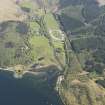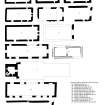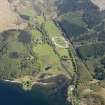St Maelrhuba's Chapel And Graveyard
Burial Aisle (16th Century), Burial Ground (Medieval), Chapel (Medieval), Grave Slab (16th Century), Grave Slab(S) (Medieval)
Site Name St Maelrhuba's Chapel And Graveyard
Classification Burial Aisle (16th Century), Burial Ground (Medieval), Chapel (Medieval), Grave Slab (16th Century), Grave Slab(S) (Medieval)
Alternative Name(s) Kilmorie, Old Parish Church, Strathlachlan Chapel; Kilmorie Church; Mclachlan Burial-aisle
Canmore ID 40556
Site Number NS09NW 2
NGR NS 01080 95172
Datum OSGB36 - NGR
Permalink http://canmore.org.uk/site/40556
- Council Argyll And Bute
- Parish Strathlachlan
- Former Region Strathclyde
- Former District Argyll And Bute
- Former County Argyll
NS09NW 2 01080 95172
See also NS09NW 6.
(NS 0106 9515) Church (NR) (In Ruins)
Kilmorie Burial Ground (NR)
OS 6" map (1900)
The chapel here is part of the original parish church, othe parish formerly being called Kilmorie (New Statistical Account [NSA] 1845) and was abandoned in 1782, when the present church was built (at NS 0212 9581). The chapel was originally three times as long as it was broad (the medieval dimensions). The foundations of the destroyed part can be traced running out to the W.
The circular burial ground is suggestive of a Celtic site, and Origines (1854) states that tradition, supported by an extant custom, places a church here at the time of the Crusades, though there appears to be no record of the church before 1543. The cemetery was still in use in 1854 as the burial place of the McLachlans. The church of Stralachlan was dedicated to St Malrubh (H Scott 1923).
M Paterson 1970
No certain foundations to the W of the chapel can be traced, although a rectangular hollow is visible. Other than the circular burial ground wall, there is no evidence to suggest an Early Christian site. The chapel has been used as a mausoleum for the McLachlans, and the burial ground is still in use.
Visited by OS (DWR) 29 September 1972
Scheduled as Kilmorie Church, burial ground and cross.
Information from Historic Scotland, scheduling document dated 13 March 2001.
INVENTORY OF GRAVEYARD AND CEMETERY SITES IN SCOTLAND REFERENCE:
Address: St Maelrhuba's Chapel Burial Ground, Kilmorie
Postcode: PA27 8BU
Status: In current use for burials
Size: 0.24 hectares, 0.60 acres
TOIDs:
Number of gravestones: 123
Earliest gravestone: 1786
Most recent gravestone: 1997
Description: Burial ground associated with a (ruined) chapel
Data Sources: OS MasterMap checked 23 September 2005; Graveyard Recording Form dated 16 March 2003
Measured Survey (1986)
RCAHMS surveyed the Old Parish Church, Kilmorie, Strathlachlanon in 1986 producing a plan at a scale of 1:100. The survey drawing was redrawn in ink and published at a scale of 1:250 (RCAHMS 1992, 159). The plan was also included in an illustration of comparative plans of medieval churches and chapels published at a scale of 1:250 (RCAHMS 1992, 11H).
Field Visit (October 1988)
The fragmentary remains of this medieval church stand in an oval churchyard on the S bank of the Strathlachlan River, 250m from the SE shore of Loch Fyne and 550m ESE of Old Castle Lachlan (No. 118). An estate plan of 1778 shows the elongated 'kirk' and a 'change-house' or inn a short distance to the N, but no enclosure, and the wooded enclosure on Langlands's plans of 1792 is of more rectangular form than the present one, which was probably rebuilt in the early 19th century (en.1). These plans still show the old church, which was replaced at about that date by a new building 1.25km to the ENE at Garbhallt (No. 103), but soon afterwards it was demolished except for the E wall and an attached burial-aisle.
Extending W of the standing remains there is a disturbed area which appears to mark the robbed walls of a building about 15m from E to W by 8m over all. The surviving E wall is 7m in width and 1m thick and its NE angle is preserved, with quoins of red sandstone in the lower part and schist above, but the S end of the wall has been truncated and patched with reused sandstone and rubble, as has the return of the N wall. The schist outer jambs of a double window, largely destroyed by an inserted archway, remain to a height of 1.23m at the S and 0.88m at the N; the schist rybats are deeply splayed, but the arch-heads have been destroyed. The NE angle of the wall has a double-cavetto sandstone skewputt resembling those of the aisle and probably of late 16th-century date.
The round-headed archway, 2.1m wide and 3m high and built with schist jambs but some sandstone in the arch-head, leads into a roofless aisle measuring 5.7m from E to W by 4.4m within walls varying from 0.8m to 1m. It was lit by two windows in the N wall and another at the E end of the S wall, and by a high-level E window, but there is no evidence that there was an upper floor. These openings have schist surrounds with 60mm chamfers and glazing grooves, while the entrance-arch, which is rebated for doors opening into the church, has a 35mm chamfer on the jambs and square-arrised arch-voussoirs. The E wall has schist quoins and skewputts resembling those described above. In the W wall, inserted below the S jamb of the medieval window, there is visible on both faces a blocked opening, 0.6m wide and 0.55m high and of unknown purpose. At the S end of the E wall is a cavetto corbel, and this wall carries a series of marble tablets commemorating members of the family of MacLachlan of MacLachlan.
Strathlachlan parish extends for about 15km along the SE shore of Loch Fyne, and inland to the watersheds with Glendaruel and Gleann Dubh. The church is first recorded in 1543, when it was stipulated that money due to Lachlan MacLachlan of MacLachlan should be paid 'upon Sanct Our Ladye alter situ at within the Kirk of Stralachlane' (en.2). The slight remains of the medieval church present few dateable features, but probably belong to the 15th century rather than an earlier period. The patronage of the church, with the parsonage and vicarage revenues, were regranted by James VI to Lachlan MacLachlan, grandson of the earlier chief of that name, in 1592 (en.3). The burial-aisle was probably added at about this period.
In the early 17th-century the parish was united to Inverchaolain, and a former association with Kilfinan (No.61) is suggested by a document of 1633 which refers to the church as 'the chapel of Kilmorich in Strathlachlan’ (en.4). Its separation from Inverchaolain was proposed in 1642 and carried into effect in 1651, when it was united with Strachur (No. 101), the manse being established in the latter parish (en.5). The name occurs in a variety of forms in the 16th and 17th centuries, including 'Kilmoir' in 1663 and 'Kilmary' in 1680, but the most common designations are Kilmory or Kilmorie 'in (the) Strae'. The dedication is variously said to have been to St Mary, to whom an altar in the church was dedicated, or to St Maelrubha, the latter being the more probable (en.6*).
An estimate for repairs, mainly to the roof but including some work on the walls of the church, was submitted in 1698, and in 1728 Lachlan MacLachlan of MacLachlan claimed exemption from arrears of teinds since he had expended a much greater sum in the past few years on repairs to the church (en.7). There is no evidence, however, of the extent to which the medieval church was modified at this period. Langlands's plans of 1792 show the old church with the narrower MacLachlan aisle at its E end, as well as the new church at Garbhallt (No. 103), but it is probable that it was demolished soon afterwards to provide material for the churchyard wall, and the building was in its present condition when seen by Howson about 1840 (en.8).
RCAHMS 1992, visited October 1988
[see RCAHMS 1992 No. 75 for a description of 4 funerary monuments]














































